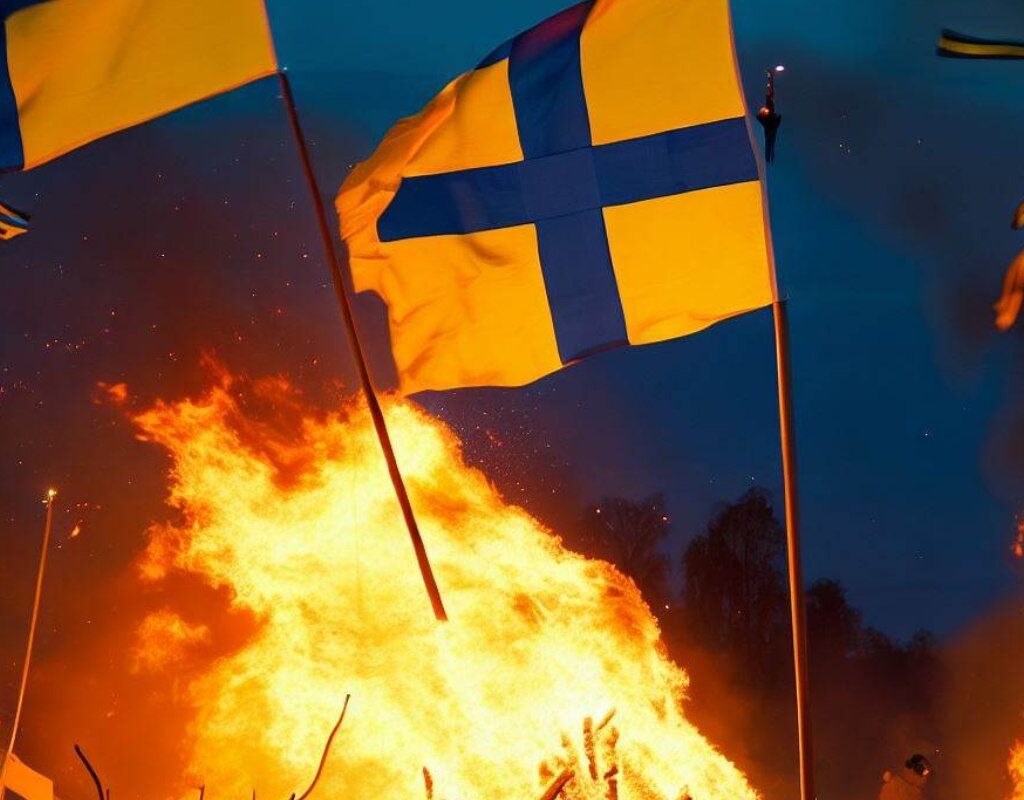Every year, at the end of April, Sweden is illuminated on the traditional Walpurgis Night. This rite which is believed to ward off evil spirits has evolved into a more festive celebration which includes the burning of unnecessary objects and the exaltation of patriotism with flags waving around every corner.
Walpurgis Ceremony: Sweden Lights Up the Night with Tradition and Fire
According to Swedish tradition, Walpurgis Night which is celebrated every year at the end of April is a time to light bonfires and celebrate in a big way.
The origin of this rite lies in the belief that fire can ward off evil spirits, although today, its practice has evolved into a more festive ritual which includes the burning of unnecessary objects accumulated in gardens.
During this vibrant event, it’s not unusual to find Swedish flags waving around every corner, adding to the festive air.
This show of patriotism has a special reason: April 30, the same date as Walpurgis is the birthday of King Charles Gustav XVI. And the celebrations don’t stop here, as the first day of May is characterized by numerous parades and festivals across the country.
St. Walpurgis and the May Day Pagan Connection
Saint Walburga, born in Sussex around 710 and died in Heidenheim in 779, was a Benedictine nun from England, called to Germany by Saint Boniface to lead the convent of Heidenheim.
Their festival was traditionally celebrated on May 1, a detail that resulted in the legend of the Night of Walpurgis, in which it was said that sorcerers and devils met at the Blocksberg. Despite efforts to Christianize Germany, pagan beliefs and rituals continued to exist over the centuries.
These popular traditions were kept alive through women who, marginalized from medieval society, played roles as healers, soothsayers or midwives. However, with the growing power of the Church and the Papacy during the Late Middle Ages, tolerance for those considered outside the established order such as heretics (Cathars, Hussites) and witches, began to diminish. This led to an era of violent persecution.
An important milestone in this offensive against witches’ practices was the publication in 1487 of the “Malleus Maleficarum” by the Dominicans Heinrich Kramer and Jacob Sprenger. This manual, translated as “The Hammer of the Witches” became a reference for the procedures to be followed in witch trials, thus reinforcing the systematic persecution of these women for centuries.
The Protestant Reformation and Its Impact on the Witch Hunt
Contrary to what one might expect, the Protestant Reformation did not end the persecution of witches but in many ways, intensified it. In fact, it is estimated that the number of witches executed in Protestant Germany exceeded the total number of victims of the Inquisitorial Orders of Faith across Europe.
Prominent figures of the Reformation such as Martin Luther, John Calvin and Ulrich Zwingli, instead of challenging the prevailing view of witchcraft, endorsed and even promoted it. Their fervent support for witch-hunts resulted in a period of even more violent and systematic persecution than during the Late Middle Ages.
The supposed German witches, according to legend, held their annual covens during the night of Saint Walpurgis, on April 30, on the slopes of Mount Harz, a majestic mountain range that today separates the states of Lower Saxony and Saxony-Anhalt.
This fact further contributed to today’s association with magic and occultism, a perception that, although transformed, endures to this day.
Goethe, Faust and the Description of the Pagan Rituals on the Harz Mountain
In the famous work “Faust” by Johann Wolfgang von Goethe, Walpurgis’s night rituals are vividly and fascinatingly described.
In one of the most memorable episodes, the main character, Faust, is taken by Mephistopheles, one of the pseudonyms of the devil to Mount Brockensberg in the Harz mountain range. This detail not only contributes to the enigma of the work but also adds to the cultural narrative of Walpurgis Night and its relationship with occult practices.
Roots in Ancient Pagan Folklore
Walpurgis Night is a holiday that sinks deep into ancient pagan folklore. Originally, this celebration was dedicated to the goddess of fertility Walburga and coincided with the Celtic Beltaine which was celebrated on the first new moon after the spring equinox.
With the adoption of the Gregorian calendar, the date of this holiday was finally fixed on April 30.
In an effort to eradicate the pagan vestiges of the celebration, the Church dedicated the date to Saint Walpurgis, the abbess of the Heidenheim monastery in Franconia, who was canonized on May 1, 870 according to some records.
It is currently credited with protecting against the evil eye and other curses attributed to witches, providing an interesting bridge between medieval history and modern celebrations.
Beltane: From Viking Tradition to Modern Celebration
Beltane is a holiday that has its roots in ancient Viking and Celtic traditions. This holiday represents the transition from winter to spring and is celebrated in honor of Belenos, the Celtic god of fire.
In commemoration, bonfires are lit and the resulting smoke symbolizes purification and renewal for villages and their inhabitants.
Over time, Beltane was adopted and adapted for certain witchcraft rituals. As is often the case with many pagan traditions with the arrival of Christianity, new meanings were assigned to it, some even loosely relating it to a supposed birthday of Satan.
According to legends, during the equinoctial transition, witches met near the Harz mountain range, specifically at its highest peak, the Blocksberg. These meetings are an integral part of the folklore surrounding Walpurgis Night.
The origin of Beltane dates back to ancient Celtic pagan celebrations, possibly influenced by the Vikings.
During the night of April 30, the gods of fertility were honored and invoked in a celebration that amalgamated elements of Nordic and Celtic culture. This mix of traditions has lasted to this day, creating a rich and varied cultural heritage that is still being celebrated.
May: Sacred Month for Ancestors in Ancient Rome
In ancient Rome, May was a month dedicated to the ancestors, or ‘elders’. It was believed that during this time, throughout Europe and Asia, the spirits of the deceased made inroads into the world of the living.
Both in ancient and the Middle Ages, one important warning persisted: avoid getting married in May. The fear lay in the risk of marrying a ghost or an enchanted woman from the Other World.
Saint Walpurgis and the Transition of Dates
Over time, the date of the Catholic celebration of the canonization of Saint Walpurgis, also known as Valborg or Walburga, was moved from February 25, her date of birth, to May 1.
This change resulted in the naming of Walpurgis Night which coincides with Saint Walpurgis Day in the Swedish calendar. This association is due to the fact that May 1, 870 A.D., was the day on which their relics were moved.
Later, this date became the day of celebration of this saint in some calendars, also coinciding with International Labor Day.
The Night of Walpurgis and the Creation of the Illuminati
Finally, it is important to highlight a historic milestone linked to Walpurgis Night. It was during this night in 1776 that Adam Weishaupt founded the secret society of the Illuminati in the Bavarian forests. This association persists in popular culture and continues to be the subject of fascination and speculation.




